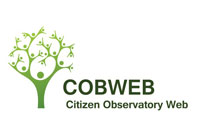Smartphone environment

Cobweb - Citizen Observatory Web
17 January 2013
Researchers at Aberystwyth University are set to use information collected on smart phones by people living in the area around the Dyfi estuary to improve flood prediction models and record changes to habitats.
The work forms part of part of COBWEB (Citizen OBservatory WEB), a new four year £8.5m European Union funded project to develop an "observatory framework" that will make it easier for citizens to collect environmental data suitable for use in research, decision making and policy formation.
£1.7m of the project’s funding will focus on four organisations working on the UNESCO-designated Dyfi Biosphere (http://www.biosfferdyfi.org.uk/); EcoDyfi, Aberystwyth based company Environment Systems, Welsh Government and Aberystwyth University.
The project is built around UNESCO’s World Network of Biosphere Reserves (WNBR), with test areas in Biosphere Reserves within the UK, Germany and Greece.
Led by the University of Edinburgh, COBWEB consists of thirteen partners from five European member states: UK, Germany, Greece, The Netherlands and Ireland.
Funding comes from the EU’s FP 7 Programme, which is designed to respond to Europe's employment needs, competitiveness and quality of life.
The infrastructure developed will explore the possibilities of crowd sourcing techniques around the concept of “people as sensors”, particularly the use of mobile devices for data collection and geographic information.
Concentrating initially on the Welsh Dyfi Biosphere Reserve, the project aims to use the enthusiasm of local Biosphere Reserve communities for improved environmental decision making to help develop technology that will eventually be more widely applicable.
The work at Aberystwyth University will be undertaken by the Centre for Catchment and Coastal Research, and the River Basin Dynamics & Hydrology / Earth Observation research groups.
They Aberystwyth researchers will be using COBWEB to improve flood prediction models and to classify the change in important habitats in the Dyfi Biosphere.
Professor Richard Lucas, Head of the Remote Sensing Research Group at Aberystwyth University welcomed the announcement; “The increasing ownership of smart phones can allow large portions of the population to act as "sensors" to collect and send environmental information that can be analysed and used to improve peoples' quality of life and to help improve the sustainability of our decision-making. This is a real opportunity for the University to help connect citizens with politicians and academic researchers.”
“We are also looking forward to working with the other partners from 5 countries; introducing them to the internationally important Dyfi Valley and its rich Welsh Culture."
COBWEB Project Coordinator Chris Higgins, of Edinburgh University based EDINA, said: "Biosphere reserves are beautiful areas with people living in them who want to keep them that way. Using smartphone technology to get citizens more involved in decision making is a hot research area. Empowering people and improving information flow is vital to addressing a range of environmental issues."
Dr Iolo ap Gwynn, Chair of the Dyfi Biosphere Partnership, explained; “Ecodyfi staff will lead the Partnership’s efforts to help people explore how new technology can help us get involved in recording the detail and location of valued plants and animals such as fish and bees, and of invasive species such as Japanese Knotweed. However, we expect most attention to be paid to flooding, which should improve the models that predict where it is likely to happen.”
Steve Keyworth, Environment Systems’ Commercial Director, said; “This is a really exciting project which not only leverages our experience in Earth Observation and professional survey but also empowers citizens’ associations in environmental decision making.
“There will also be considerable shared learning and knowledge transfer that will help to produce application models that work across different European countries and become accepted as the de facto information system of the WNBR.”
Peter Burnhill, Director of EDINA, said: “This work aims to enable the citizen to use the Mobile Internet to benefit the Earth in a direct and obvious way, locally and therefore globally. The project allows EDINA and the University of Edinburgh to build on previous experience in EU projects in geo-spatial research and development. Undoubtedly a significant challenge, it is also opportunity to provide leadership for international experts drawn from universities in five other countries and from organisations across Government, NGO and the commercial sectors – all committed to assist environmental sustainability.”
The COBWEB Project Partners:
• EDINA, part of the University of Edinburgh (Co-ordinator)
• Aberystwyth University
• Welsh Government
• Environment Systems Limited, Aberystwyth
• Ecodyfi
• University College Dublin/ National University of Ireland, Dublin
• The University of Nottingham
• Open Geospatial Consortium (Europe) Limited
• Technische Universitaet Dresden
• Secure Dimensions GmbH
• University of Western Greece
• OIKOM – Environmental Studies Ltd
• GeoCat BV



